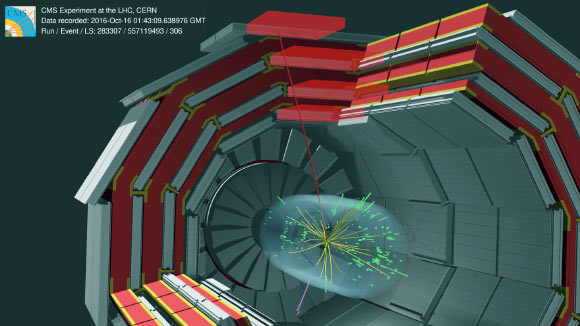
In the Standard Model of particle physics, the masses of the carriers of the weak interaction, the W and Z bosons, are uniquely related. Physics beyond the Standard Model can change this relationship through the effects of virtual particle quantum loops, thus making it of paramount importance to measure these masses with the highest possible precision. While the mass of the Z boson is known to the remarkable precision of nearly 20 parts per million (2 MeV), the W boson mass is known much less precisely. The new measurement, which is a first for the Compact Muon Solenoid (CMS) experiment at CERN’s Large Hadron Collider (LHC), uses a new technique that makes it the most elaborate investigation of the W boson’s mass to date.

CMS candidate collision event for a W boson decaying into a muon (red line) and a neutrino that escapes detection (pink arrow). Image credit: CMS / CERN.
In the Standard Model, the W mass is related closely to the strength of the interaction unifying the electromagnetic and weak forces and to the masses of the Higgs boson and the top quark, which constrain its value to 80353 million electronvolts (MeV) within an uncertainty of 6 MeV.
Measuring the W boson mass with high precision therefore makes it possible to test whether or not these properties all align in a way that is consistent with the Standard Model.
If they don’t, the cause could be new physics phenomena such as new particles or interactions.
Since its discovery at CERN about 40 years ago, the W boson has had its mass measured ever more precisely by several collider experiments.
In 2022, a surprisingly high value of its mass measured by the Collider Detector at Fermilab (CDF) plunged the particle into a ‘midlife crisis.’
The CDF W boson mass, 80433.5 MeV with an uncertainty of 9.4 MeV, differed significantly from the Standard Model prediction and from the other experimental results, calling for more studies.
In 2023, the ATLAS Collaboration at CERN, which provided its first W boson mass measurement in 2017, released an improved measurement based on a reanalysis of proton-proton collision data from the first run of the LHC.
This improved result, 80366.5 MeV with an uncertainty of 15.9 MeV, lined up with all previous measurements except the CDF measurement, which remains the most precise to date, with a precision of 0.01%.
The CMS experiment has now contributed to this global endeavor with its first W boson mass measurement.
The keenly anticipated result, 80360.2 with an uncertainty of 9.9 MeV, has a precision comparable to that of the CDF measurement and is in line with all previous measurements except the CDF result.
“This analysis is the first attempt to measure the W mass in the harsh collision environment of the second running period of the LHC,” said Dr. Patricia McBride.
“And all the hard work from the team has resulted in an extremely precise W mass measurement and the most precise measurement at the LHC.”
“W mass measurements are very challenging, involving delicate measurements and theoretical modeling of the production of the W boson and its decay into a lepton (here, a muon) and a neutrino that escapes detection,” added Dr. Gautier Hamel de Monchenault.
“By exploiting the ability of the CMS detector to measure muons with high precision and using the latest and most advanced theoretical ingredients, some of which were tested by a cross-checking analysis, we attained this record level of precision.”
 Print
Print


